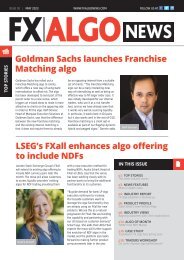e-Forex July 22
Create successful ePaper yourself
Turn your PDF publications into a flip-book with our unique Google optimized e-Paper software.
TRADING OPERATIONS<br />
Bringing more transparency and efficiency to the FX Liquidity Management process<br />
“For liquidity takers, it is not always as simple as picking the<br />
top five by market share. We want to take out the guesswork<br />
on what it is still a speculative exercise.”<br />
Guy Hopkins<br />
and this is still the case,” says Stead.<br />
“Those relationships should be based<br />
on trust because you want liquidity<br />
partners not providers. The LiquidityFX<br />
Solution including AlgoBox and AI<br />
Analytics provided by smartTrade<br />
allows for trust with verification.”<br />
DATA-DRIVEN PROCESS<br />
There has been a fundamental shift in<br />
liquidity management. It is now more of<br />
a data-driven process, says Guy Hopkins,<br />
founder and CEO of FairXchange.<br />
“Previously, the big liquidity providers<br />
would go to their clients and present<br />
them with all this information in terms of<br />
what’s working well and what is not. But<br />
each liquidity provider would have their<br />
own format and this would give clients<br />
no way to compare the data between<br />
liquidity providers and to respond to<br />
the information. It is now a far more<br />
systematic and robust process,” says<br />
Hopkins.<br />
This is not to say that challenges<br />
do not remain. One of these is the<br />
increased use of FX aggregation.<br />
Some FX trading firms are using up<br />
to three or four aggregators, all with<br />
their own data format, which makes<br />
it difficult for firms to see the bigger<br />
picture when it comes to data analysis,<br />
says Hopkins. Consequently there is<br />
a premium on services and providers<br />
that can consolidate this data, such<br />
as the rising number of third party<br />
liquidity managers that include<br />
FairXchange.<br />
There are some similarities with<br />
the growth of TCA and the use of<br />
independent providers. However,<br />
while independence is helpful for<br />
liquidity management, the mainfocus<br />
is the ability to capture and<br />
consolidate the data, says Hopkins.<br />
“TCA and best execution are more<br />
regulatory-driven processes, whereas<br />
liquidity management is more<br />
commercially-driven. Firms now<br />
realise the value of that market-wide<br />
data and why it is so important. For<br />
example, the firms doing the liquidity<br />
management are not always the<br />
originators of the trade, so they have<br />
to be aware of why trades are not<br />
working,” he states.<br />
Liquidity fragmentation remains<br />
an issue, says Hopkins. “FX is not a<br />
complex asset class – whoever is on<br />
the other side does not really have any<br />
bearing on the data. But people do<br />
need to think about liquidity recycling.<br />
With new liquidity providers that you’re<br />
onboarding, you have to assess whether<br />
that liquidity is genuine. There is also<br />
the leakage of skews – when liquidity<br />
providers send out their indications of<br />
interest, they do not want to see the<br />
market using that information against<br />
them back in the lit market. It is a big<br />
challenge,” says Hopkins.<br />
In the past, liquidity management was<br />
primarily based on spread and market<br />
share but there are now many more<br />
nuances factored in, such as the cost<br />
of rejection, so that trading firms get<br />
a better idea of the total value that a<br />
liquidity provider brings, says Hopkins.<br />
“The knack is to produce information<br />
that liquidity takers actually need.”<br />
It is also about providing information<br />
that is actionable, such as making<br />
changes to the panel of liquidity<br />
providers, something that may require<br />
new trading and credit agreements<br />
plus lots of testing. “There is a lot<br />
of operational expense borne by the<br />
business when it comes to changing<br />
the panel of liquidity providers,” says<br />
Hopkins. “So it is important to know<br />
the economic cost of that change and<br />
the potential upside for both liquidity<br />
takers and providers.”<br />
It is about making the selection of<br />
liquidity providers a data-driven<br />
exercise, says Hopkins. “For liquidity<br />
takers, it is not always as simple as<br />
picking the top five by market share.<br />
We want to take out the guesswork<br />
on what it is still a speculative exercise.<br />
So we promote the modelling of this<br />
process in advance using broader data.<br />
And for liquidity providers, it helps<br />
them to get a better idea of their<br />
customer service and makes for a far<br />
more constructive relationship.”<br />
Ultimately, FX is still about relationshipdriven<br />
trading, says Hopkins. And while<br />
liquidity management may be more<br />
data-driven, it is about using that data<br />
for practical changes. This means that<br />
the data is not just used by teams<br />
of quantitative analysts for number<br />
crunching but also by sales teams for<br />
client pitches, for example.<br />
“In the old days, a sales person would<br />
go to the quants and say tighten our<br />
pricing to make us more competitive,”<br />
says Hopkins. “That has changed<br />
now and sales people are going back<br />
to their clients and have the data to<br />
support the discussion about how they<br />
make the most appropriate changes to<br />
the relationship.”<br />
26 JULY 20<strong>22</strong> e-FOREX

















